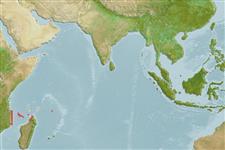Klassifizierung / Names
Namen | Synonyme | Catalog of Fishes(Gattung, Arten) | ITIS | CoL | WoRMS | Cloffa
>
Ovalentaria/misc (Various families in series Ovalentaria) >
Pseudochromidae (Dottybacks) > Congrogadinae
Etymology: Halimuraena: Greek, als, alis = salt + Latin, muraena = morey eel (Ref. 45335); lepopareia: Name from the Greek word 'lepos'(= a scale) and 'pareia' (= a cheek), referring to the diagnostic scaled cheek; noun in apposition..
More on author: Winterbottom.
Environment: milieu / climate zone / depth range / distribution range
Ökologie
seewasser riff-verbunden; tiefenbereich 0 - 2 m. Tropical; 10°S - 16°S
Western Indian Ocean: Pamanzi Island, Comoros to Nossi Bé, northern Madagascar.
Size / Gewicht / Alter
Maturity: Lm ? range ? - ? cm
Max length : 7.4 cm SL Männchen/unbestimmt; (Ref. 675)
Kurzbeschreibung
Morphologie | Morphometrie
Rückenflossenstacheln (insgesamt): 1; Rückenflossenweichstrahlen (insgesamt): 47-50; Afterflossenstacheln 0; Afterflossenweichstrahlen: 37 - 40. Gill membranes fused ventrally but free from isthmus. Shoulder with a dark ocellated spot. Preopercular canal with 6 pores; 8 suborbital pores; possess a bilateral, anterior interorbital pore. Cheeks, opercles and nape scaled. Second intermittent lateral line along midlateral septum, with 18-56 pored scales.
Inhabits shallow water among weed, rock, and coral.
Life cycle and mating behavior
Geschlechtsreife | Fortpflanzung | Ablaichen | Eier | Fecundity | Larven
Winterbottom, R., 1985. Revision and vicariance biogeography of the subfamily Congrogadidae (Pisces: Perciformes: Pseudochromidae). Indo-Pac. Fish. (9):34 p. (Ref. 531)
IUCN Rote Liste Status (Ref. 130435)
Bedrohung für Menschen
Harmless
Nutzung durch Menschen
Mehr Information
NamenSynonymeMetabolismusRäuberÖkotoxikologieFortpflanzungGeschlechtsreifeAblaichenSpawning aggregationFecundityEierEientwicklung
Alter/GrößeWachstumLänge-GewichtLänge-LängeLängenhäufigkeitenMorphometrieMorphologieLarvenLarven Pop.Dyn.RekrutierungDichteBRUVS
ReferenzenAquakulturAquakultur ProfilZuchtlinienGenetikElectrophoresesVererbbarkeitKrankheitenVerarbeitungNutrientsMass conversion
PartnerBilderStamps, Coins Misc.LauteCiguateraGeschwindigkeitSchwimmstilKiemenoberflächeOtolithsGehirngrößeSehfähigkeit
Tools
Zusatzinformationen
Download XML
Internet Quellen
Estimates based on models
Preferred temperature (Ref.
123201): 26.8 - 27.9, mean 27.5 °C (based on 60 cells).
Phylogenetic diversity index (Ref.
82804): PD
50 = 0.6250 [Uniqueness, from 0.5 = low to 2.0 = high].
Bayesian length-weight: a=0.00102 (0.00046 - 0.00225), b=3.06 (2.88 - 3.24), in cm total length, based on all LWR estimates for this body shape (Ref.
93245).
Trophic level (Ref.
69278): 3.8 ±0.6 se; based on size and trophs of closest relatives
Fishing Vulnerability (Ref.
59153): Low vulnerability (10 of 100).
